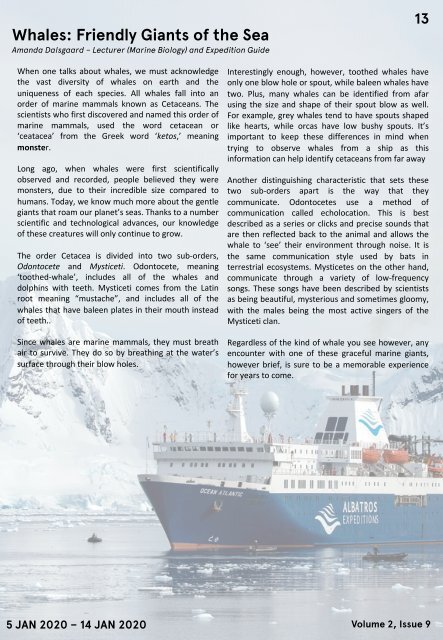V9 Antarctic Peninsula_Voyage_Log
Create successful ePaper yourself
Turn your PDF publications into a flip-book with our unique Google optimized e-Paper software.
Whales: Friendly Giants of the Sea<br />
Amanda Dalsgaard – Lecturer (Marine Biology) and Expedition Guide<br />
13<br />
When one talks about whales, we must acknowledge<br />
the vast diversity of whales on earth and the<br />
uniqueness of each species. All whales fall into an<br />
order of marine mammals known as Cetaceans. The<br />
scientists who first discovered and named this order of<br />
marine mammals, used the word cetacean or<br />
‘ceatacea’ from the Greek word ‘ketos,’ meaning<br />
monster.<br />
Long ago, when whales were first scientifically<br />
observed and recorded, people believed they were<br />
monsters, due to their incredible size compared to<br />
humans. Today, we know much more about the gentle<br />
giants that roam our planet’s seas. Thanks to a number<br />
scientific and technological advances, our knowledge<br />
of these creatures will only continue to grow.<br />
The order Cetacea is divided into two sub-orders,<br />
Odontocete and Mysticeti. Odontocete, meaning<br />
‘toothed-whale’, includes all of the whales and<br />
dolphins with teeth. Mysticeti comes from the Latin<br />
root meaning “mustache”, and includes all of the<br />
whales that have baleen plates in their mouth instead<br />
of teeth..<br />
Since whales are marine mammals, they must breath<br />
air to survive. They do so by breathing at the water’s<br />
surface through their blow holes.<br />
Interestingly enough, however, toothed whales have<br />
only one blow hole or spout, while baleen whales have<br />
two. Plus, many whales can be identified from afar<br />
using the size and shape of their spout blow as well.<br />
For example, grey whales tend to have spouts shaped<br />
like hearts, while orcas have low bushy spouts. It’s<br />
important to keep these differences in mind when<br />
trying to observe whales from a ship as this<br />
information can help identify cetaceans from far away<br />
Another distinguishing characteristic that sets these<br />
two sub-orders apart is the way that they<br />
communicate. Odontocetes use a method of<br />
communication called echolocation. This is best<br />
described as a series or clicks and precise sounds that<br />
are then reflected back to the animal and allows the<br />
whale to ‘see’ their environment through noise. It is<br />
the same communication style used by bats in<br />
terrestrial ecosystems. Mysticetes on the other hand,<br />
communicate through a variety of low-frequency<br />
songs. These songs have been described by scientists<br />
as being beautiful, mysterious and sometimes gloomy,<br />
with the males being the most active singers of the<br />
Mysticeti clan.<br />
Regardless of the kind of whale you see however, any<br />
encounter with one of these graceful marine giants,<br />
however brief, is sure to be a memorable experience<br />
for years to come.<br />
5 JAN 2020 – 14 JAN 2020<br />
Volume 2, Issue 9

















